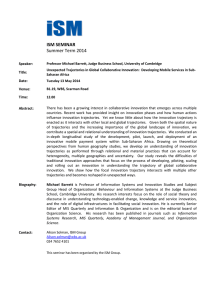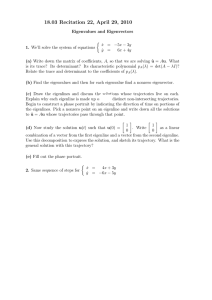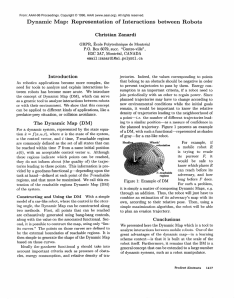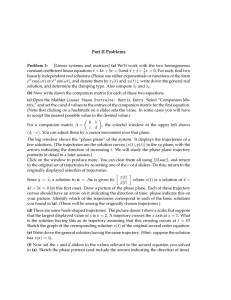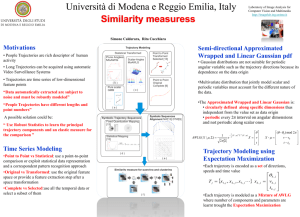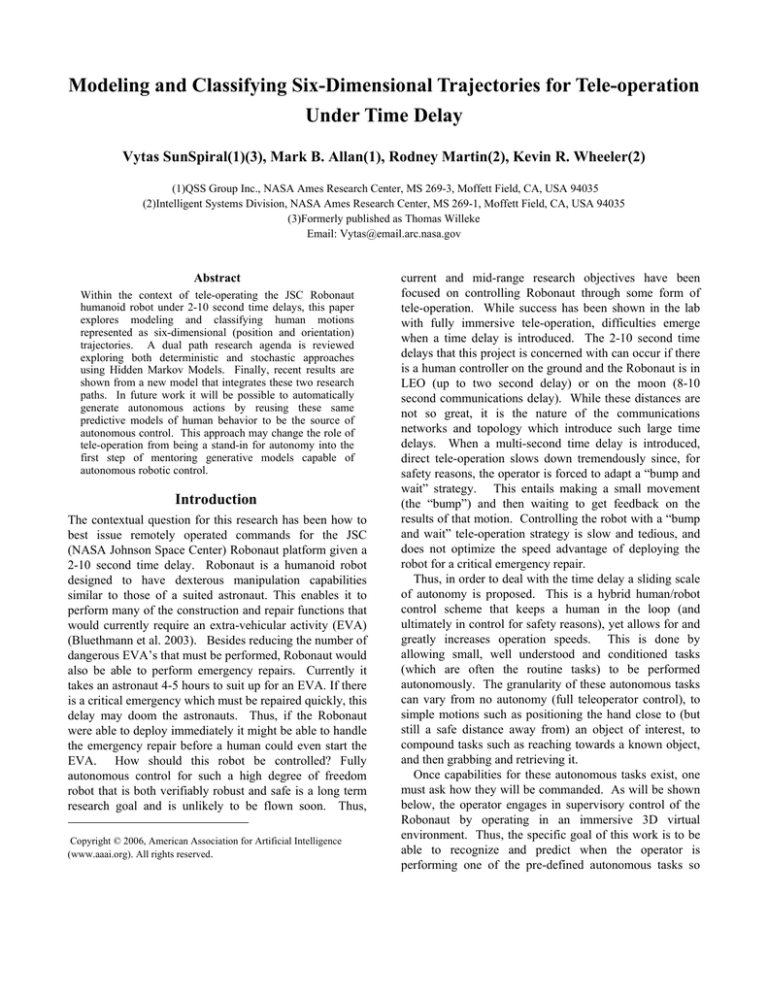
Modeling and Classifying Six-Dimensional Trajectories for Tele-operation
Under Time Delay
Vytas SunSpiral(1)(3), Mark B. Allan(1), Rodney Martin(2), Kevin R. Wheeler(2)
(1)QSS Group Inc., NASA Ames Research Center, MS 269-3, Moffett Field, CA, USA 94035
(2)Intelligent Systems Division, NASA Ames Research Center, MS 269-1, Moffett Field, CA, USA 94035
(3)Formerly published as Thomas Willeke
Email: Vytas@email.arc.nasa.gov
Abstract
Within the context of tele-operating the JSC Robonaut
humanoid robot under 2-10 second time delays, this paper
explores modeling and classifying human motions
represented as six-dimensional (position and orientation)
trajectories. A dual path research agenda is reviewed
exploring both deterministic and stochastic approaches
using Hidden Markov Models. Finally, recent results are
shown from a new model that integrates these two research
paths. In future work it will be possible to automatically
generate autonomous actions by reusing these same
predictive models of human behavior to be the source of
autonomous control. This approach may change the role of
tele-operation from being a stand-in for autonomy into the
first step of mentoring generative models capable of
autonomous robotic control.
Introduction
The contextual question for this research has been how to
best issue remotely operated commands for the JSC
(NASA Johnson Space Center) Robonaut platform given a
2-10 second time delay. Robonaut is a humanoid robot
designed to have dexterous manipulation capabilities
similar to those of a suited astronaut. This enables it to
perform many of the construction and repair functions that
would currently require an extra-vehicular activity (EVA)
(Bluethmann et al. 2003). Besides reducing the number of
dangerous EVA’s that must be performed, Robonaut would
also be able to perform emergency repairs. Currently it
takes an astronaut 4-5 hours to suit up for an EVA. If there
is a critical emergency which must be repaired quickly, this
delay may doom the astronauts. Thus, if the Robonaut
were able to deploy immediately it might be able to handle
the emergency repair before a human could even start the
EVA. How should this robot be controlled? Fully
autonomous control for such a high degree of freedom
robot that is both verifiably robust and safe is a long term
research goal and is unlikely to be flown soon. Thus,
Copyright © 2006, American Association for Artificial Intelligence
(www.aaai.org). All rights reserved.
current and mid-range research objectives have been
focused on controlling Robonaut through some form of
tele-operation. While success has been shown in the lab
with fully immersive tele-operation, difficulties emerge
when a time delay is introduced. The 2-10 second time
delays that this project is concerned with can occur if there
is a human controller on the ground and the Robonaut is in
LEO (up to two second delay) or on the moon (8-10
second communications delay). While these distances are
not so great, it is the nature of the communications
networks and topology which introduce such large time
delays. When a multi-second time delay is introduced,
direct tele-operation slows down tremendously since, for
safety reasons, the operator is forced to adapt a “bump and
wait” strategy. This entails making a small movement
(the “bump”) and then waiting to get feedback on the
results of that motion. Controlling the robot with a “bump
and wait” tele-operation strategy is slow and tedious, and
does not optimize the speed advantage of deploying the
robot for a critical emergency repair.
Thus, in order to deal with the time delay a sliding scale
of autonomy is proposed. This is a hybrid human/robot
control scheme that keeps a human in the loop (and
ultimately in control for safety reasons), yet allows for and
greatly increases operation speeds. This is done by
allowing small, well understood and conditioned tasks
(which are often the routine tasks) to be performed
autonomously. The granularity of these autonomous tasks
can vary from no autonomy (full teleoperator control), to
simple motions such as positioning the hand close to (but
still a safe distance away from) an object of interest, to
compound tasks such as reaching towards a known object,
and then grabbing and retrieving it.
Once capabilities for these autonomous tasks exist, one
must ask how they will be commanded. As will be shown
below, the operator engages in supervisory control of the
Robonaut by operating in an immersive 3D virtual
environment. Thus, the specific goal of this work is to be
able to recognize and predict when the operator is
performing one of the pre-defined autonomous tasks so
that the action can be triggered early and completed by the
robot. The control of these autonomous actions is
purposefully kept in physical context (as opposed to
developing some command grammar) to facilitate the
seamless transition between direct tele-operation control
and the varying levels of autonomous actions.
Along side this goal of helping control the Robonaut
under a time delay, we are also using this work to advance
our research into automating the process of creating
autonomous robotic actions by modeling human behavior.
If we can accurately understand and model the methods
humans use to solve certain problems, then it is possible
that those very same models can be used to control a
humanoid robot like Robonaut to accomplish similar tasks.
Thus, we view tele-operation not simply as a means to
accomplish a task in the absence of robust autonomy, but
rather as the first step in building models of human action
for the purpose of developing robust autonomous control
(Peters et al. 2003).
The current method of controlling Robonaut involves
the operator wearing two data gloves that are used to
measure finger joint positions, and two magnetic trackers
used to measure the x-y-z position and roll-pitch-yaw
orientation of each hand (end effector). The position and
orientation information is then transmitted to the robot as
end effector position commands. The number of degrees of
freedom in the elbow and shoulder are constrained to
enable this position while maximizing strength. For safety
considerations, the rate of movement of the arms is limited;
thus the operators are trained to match or move slower than
this rate. Most of the feedback to the operator comes from
the stereo cameras mounted in the head of Robonaut and
transmitted back to the tele-operator’s head mounted
display. An operator will reach for an object so that his
view from the head mounted cameras is not obscured by
the hand. This results in some simple tasks taking a very
long time to accomplish. For example, in grasping a hand
rail (as a rung of a ladder) the operator must make sure that
the fingers can safely wrap around the rail using the stereo
visual cues. This action typically takes several seconds for
an experienced operator.
The tasks consist of the following steps:
1. Start in initial position/state
2. Look down at hand (substitute for proprioreceptive feedback) and then at hand rails
3. Reach for specified hand rail (either vertical
or horizontal according to plan)
4. Grasp hand rail
5. Remove hand rail from wall (pull)
6. Move hand rail over box
7. Drop hand rail into box
8. Return to initial position
The Robonaut can be operated via a simulated
environment, so that the operators can perform tasks
without regard for the time-delay normally associated with
long distance operations. The motion commands generated
in the simulated environment are then sent to the actual
robot for execution. For this experiment, inexperienced
operators tended to have greatly varying behaviors,
whereas the variance in the data was negligible for the
most experienced tele-operator. Fig. 1 shows the simulated
environment in which the experiments discussed in this
paper were conducted. These experiments were conducted
on many different days over six months. Initial conditions
varied noticeably from day to day.
Experiments
We chose two basic tasks, retrieving a hand rail mounted
vertically and dropping it into a box, and retrieving a hand
rail mounted horizontally and dropping it into a box. The
hand rails are mounted with Velcro on a board, affixed to a
stationary wall. The target box is a flexible cloth box that is
open but is not within the same field of view as the hand
rails. These tasks were chosen as a first step towards
automating climbing on a space habitat or operating a
drawer pulling sequence.
Figure 1 – Top: Simulation based experiment.
Bottom: The operator’s view from the left and right
cameras of the simulated hand rails.
Technical Problem
While there are a number of technical and design
challenges to the larger problem we are solving, the core
problem is modeling and classification of the six
dimensional trajectories.
Each trial can be cut into a sequence of trajectory
segments. In this work we focus on the first segment,
which goes from the start position to one of the possible
graspable objects. These trajectories are a time-stamped
sequence of the X, Y, Z, location of the operator’s hand
and the associated rotation matrix, which we cast into a
roll, pitch, yaw representation. Thus, the trajectories are a
time sequence of six-dimensional data points with messy
initial conditions.
Since the operator starts in
approximately the same location for every motion, the
initial segments of all the trajectories are heavily
overlapped, making it difficult to clearly separate them in
the early part of the motion (Fig. 2). Furthermore, this is
compounded by a large day-to-day variance on the
operator’s start position. (Within a single day’s trials the
trajectories tend to cluster fairly nicely). This nonstationarity means that there is a wide variance on the
motion and location of the trajectories, and that in some
cases the initial motions towards different objects end up
looking very similar (Fig. 3).
Our task is: given a set of example six-dimensional
trajectories to certain known points in space, develop
meaningful models of the different trajectories, and then
use those models to classify a new trajectory in real time,
as soon as possible (i.e. while having seen only some initial
segment of the trajectory), and with no false alarms (i.e. it
is better to not classify than to give the wrong
classification).
Notice that the solution to this problem, which was
motivated by tele-operation and user intent prediction, can
be used in other ways. Specifically, it really is about
classifying and predicting human gestures. Thus, if a robot
were working side by side with a human, and assuming
there was a good solution for visually capturing the motion
of the human’s hand or arm, this trajectory classification
method could be used to comprehend the intent behind the
human’s motions, such as for which object the human was
reaching. And, as mentioned earlier, we hope that the
same models could be reused to generate autonomous
control.
Development Approach
We explored in parallel different approaches to solving this
problem. One track continued with previous work by
applying stochastic methods, such as using Hidden Markov
Models to classify the trajectories. The other track looked
at more deterministic methods and ended up exploring
different spatial representations of the data. This research
approach has been very successful, with the two different
tracks starting to converge and borrow techniques from
each other.
In the following section we will try to present the
evolution of our thoughts on these two different tracks, and
show how they have influenced each other.
Figure 2 - This is a plot of the XYZ position information
of many trajectories to two different handles. The start
location on the right shows how the initial conditions for
the different trajectories are heavily overlapped.
Figure 3 - This is the same data as figure 2, but viewed at
a different angle to highlight the spatial variance of the
start positions.
Deterministic Approach
At first we thought that predicting which object an operator
was reaching for would be easy to solve using some simple
heuristic. It turned out to be a much more interesting
modeling problem than we anticipated. This section will
give a high-level outline of our exploration of the solution
space, and will show how we developed our newest
algorithms.
Our first thought was to calculate which object the
operator was “moving towards the most” -- i.e. find the
first derivative of the motion, using position information
exclusively. The major lesson from this approach was the
importance of orientation. We found examples in which
the operator was positioning the hand to be in the correct
orientation to grab the target handrail, yet the motion to do
this involved moving towards some other object.
Our next step was to combine instantaneous orientation
and motion vectors, but we still ran into problems.
Looking at instantaneous minimum values is similar to a
minimal path approach (greedy algorithm). It turns out
that operators do not follow a minimum-distance path in
either position or orientation space. The operators have
been trained to move in such a way as to avoid
singularities, self contact and other hazards for the robot.
Also, since control is purely visual (they use no forcefeedback information), they always move so as to maintain
visual contact with both the object and the hand. This
leads to a preference for underhand grasps so that the
operator can see when the object is properly grasped. An
overhand grasp would occlude the object being
manipulated. All these constraints result in motion paths
that are not necessarily the shortest distance or most direct
motion towards the goal.
While it might be possible to enumerate all the
competing optimization constraints that the operator is
solving (occlusions, singularities, collision avoidance, etc),
we started modeling the trajectories following our belief
that good models can be used to create autonomy. We
started by explicitly modeling the gesture trajectories in
six-dimensional space (X,Y,Z, Roll, Pitch, Yaw). To make
this a proper spatial model that was independent of time
(and thus independent of the speed at which the operator
moved), we normalized along the length of the trajectory
itself. In other words, we recast the data into a new set of
data points which were a known distance apart along the
piecewise linear direction of travel. The overall shape of
the plotted trajectory stayed the same, but the actual data
points which represent the trajectory were now equidistant
along the trajectory itself.
Using this new representation an “average” trajectory
was computed for each graspable object. A method of
comparing two trajectories was developed by calculating
the average distance error and then novel trajectories were
compared to these canonical averages. The weakness of
this is that the high degree of variance and overlap,
especially in the early part of the trajectories, caused many
false alarms (i.e. matching to the wrong trajectory).
In order to capture this variance a memory based
approach was experimented with where all the trajectories
in the training set were kept in memory and the novel
trajectory was compared to all of them to find the best
match. A variety of different distance metrics were
experimented with. Under certain conditions this was
found to work fairly well, but was fragile to the inclusion
of outlier examples in the training set.
We decided that for a general solution involving models
of many different grasp trajectories, this memory based
approach would bog down. Thus we started looking at
statistical methods to represent clusters of trajectories.
This is where we really started to converge with the
stochastic methods which were being explored in parallel.
We will discuss that line of research next, and then discuss
the new converged algorithms in the last section.
Stochastic Approach
The research group has a strong body of experience in
applying Bayesian techniques to gesture recognition
problems (Wheeler and Jorgensen, 2003). The techniques
used for this work have its roots solidly grounded in formal
probabilistic graphical modeling. Using the junction tree
algorithm, DBN’s (dynamic bayes nets) can easily meet
the needs of any number of inferential or parameter
learning problems. In this case, the parameters we would
like to learn are those of a Gaussian mixture model, or
multi-modal Gaussian distribution which would describe a
cluster of example trajectories. In this approach we assume
that human motion, at a coarse level, is Markovian in
nature and can be broken down into discrete chunks – such
as a “start phase,” a “reaching phase,” and a “grasping
phase.” In turn, we hypothesize that each of these chunks
can be characterized probabilistically by the
aforementioned Gaussian mixture model. This is very
similar to what is done in voice/speech recognition, where
words are broken down into phonemes. The use of the
Hidden Markov Model (HMM) encapsulates all of these
ideas (DBN’s, Markov chains, Gaussian mixture
emissions), and is ubiquitous in the voice/speech
recognition community. However, these techniques have
also been applied by other researchers interested in the
field of motion classification and detection for video
sequences. This field is related closely to our problem of
motion trajectory classification, and they use similar
intuitive arguments for applying formal probabilistic
methods (Porikli 2004), (Bregler 1997), (Zhou, Gong, and
Tao 2005), (Makris and Ellis 2002), (Fablet and Bouthemy
2001).
Much of the Bayesian approach applied to the current
problem of modeling and classifying 6-D trajectories for
tele-operation under a time delay has been documented in
previous work (Wheeler et al. 2005). The common theme
has been the use of the HMM as the fundamental modeling
paradigm.
Feature selection has proven to be a very important
factor in how well the models characterize the
experimental motion trajectory-based data. Additionally, it
has played an important role in how consistently the
models and real-time recall thresholds can be optimized to
achieve the goals of no false alarms, minimum missed
detections and time to prediction. Feature selection refers
to the choice of several different combinations of feature
vectors that can be used (i.e. what comprises yt - the
observation vector at time t having dimension n). These
feature vectors act as templates for the observation
sequences used to train and recall the hidden Markov
models. “Recall” is a term that often refers to the use of the
Viterbi algorithm, but can also be used to describe any
algorithm that is used during the model testing phase, after
the models have already been trained. During real-time
recall of the models, HMMs trained on all tasks of interest
(reaching for a particular object) are arbitrated based upon
an algorithm to determine the “winning model,” or which
model best describes the streaming data.
Example feature vectors include subsets of the pose
vector, which provides point of resolution (POR) data, a
4x4 homogeneous transform matrix representing the
commanded position and orientation of the back of the
robot’s hand decomposed into position (x-y-z) and
orientation (roll-pitch-yaw). Euclidean distances to the
objects of interest being reached for can be used to form
the feature vector as well. In addition to feature selection,
the tradeoffs, advantages, and disadvantages of applying
different recall methods were studied in detail, including
their optimizations. Concerning the feature vectors,
initially we considered looking only at Y and Yaw, which
were discovered to provide good discrimination between
the different types of trajectories to distinct objects.
However, there were some problems with inconsistent
initial conditions across multiple tele-operation sessions
and multiple operators that biased the final error statistics.
Optimization has not completely resolved this problem,
which may in part be due to the small size of the validation
sets.
We’d also like to determine whether we can maximize
the robustness of our final error statistics (% false alarms
and missed detections) to minor variations in the
experimental setup. In doing so, we’ve found that
processing and testing new datasets based upon HMM
prediction models trained on previous sessions are not
sufficiently robust to changes in the experimental setup to
yield reasonable error statistics. As a result, this gives us
incentive to converge to a hybrid solution between the
Bayesian approach and the deterministic approach that
incorporates the best features of both. The first step in this
process is to study and test a new approach that takes
advantage of the spatial characterization of the trajectories
rather than their time dependence. As such, we become
much more reliant on distance to the objects of interest as
not only an element within the feature vector, but as a
method for discretizing the trajectory space, as one would
discretize pixels in a video sequence.
Converged Method
Our previous efforts to model tele-operator movements
directly resulted in fragile prediction systems that were
sensitive to relatively minor changes in the experimental
setup. The models performed well for known experimental
configurations but did not generalize to new situations.
Modifications to initial conditions, target object position
and orientation, or speed of tele-operation would result in a
significant increase in missed detections or false positives.
It became clear that massive amounts of data would have
to be collected in order to train enough models to
sufficiently cover the tele-operator's working area.
Additionally, it was unclear how well the models would
adapt to new tele-operators and how the models could be
extended to deal with non-stationary coordinate frames.
With this in mind, we have started to explore an alternate
approach which attempts to model manipulator approach
trajectories in a manner which is invariant to tele-operator
speed as well as object position and orientation.
The new method, which we call the approach manifold
method, takes an object-centric view of an approaching
manipulator. Whereas previous approaches attempted to
answer the question "Which object is the tele-operator
reaching for?” this approach asks each object in the scene
"Do you think the tele-operator is reaching for you?"
Central to this approach is the idea that there are a limited
number of ways an object can be grasped and that as the
manipulator moves towards a target object the trajectory
will eventually fall into the approach manifold. Intuitively,
the manifold is shaped somewhat like a funnel with the
narrow end at the object's grasp site. As the distance
between manipulator and object decreases, the range of
possible position and orientation values collapses. The
approach manifolds are object dependent and further
constraints can be added depending on scene construction.
As an example, a sphere floating in mid-air can be
approached from any direction, so it is possible that any
spherical object is the target as long as the manipulator
maintains an open pose and is moving in the general
direction towards the sphere. The approach trajectory for a
drill lying on a table would be considerably more
constrained. At a distance of 30cm, one would expect the
manipulator to be above the table, moving toward the
object, and be open or opening. At a distance of 10cm, one
would expect the manipulator to be directly behind the drill
handle, hand open, with index finger extended. Because
hand pose values are parameterized on distance rather than
time, tele-operator speed is irrelevant.
Because the full manifold is defined over many
dimensions (X, Y, Z, Roll, Pitch, Yaw – and could include
things like hand shape), it is somewhat difficult to
visualize. In figures 4 and 5 we show a histogram based
distribution on two of the axis, Roll and X, for the
horizontal handrail target. In the Roll distribution there is
a multi-modal distribution at greater distance, which
collapses to a single clean distribution as the hand gets
closer to the object. The X distribution is interesting
because is stays tightly focused over all distances, which is
not surprising because X is the major contributor to the
distance metric.
trajectory matches the object manifold. Scores above a
heuristically determined threshold are considered
candidates for grasping. All candidate objects then
calculate a confidence score based on their raw score and
the stability of the prediction over time, weighted by linear
distance to the manipulator.
We have started to explore replacing this binning
approach with a more general mixture of gaussians to
describe the manifold. Yet, early experiments indicate that
performance may actually degrade in this more general
approach. As is often the case, it may be that the simple
approach is superior. The current approach is producing
good results with no false positives. It has also shown
itself to be robust to changes in handrail position and novel
experimental setups not encountered in the training data.
Results
Figure 4 - Distribution of Roll values versus distance.
Figure 5 - X versus distance
This approach is still under development, but has
already shown robust results. In its current implementation
the manifolds are built by grouping together all trial data
for a certain target object. Then, for discretized distances
from the hand to the object, the mean and variance of each
variable of the hand pose is calculated. During runtime
recall, object models are selected based upon the object
types recognized by the computer vision system. Then, the
hand pose is transformed into each object’s local
coordinate system and compared to the statistics for the
object model. Each object is scored based how well the
As noted above, we have not yet fully implemented the
Approach Manifold Method (AMM), and already we are
getting some good results. Since this is still under
development, we have not yet performed rigorous
variational testing. However, not only are the results good
on their own terms (100% correct predictions), they also
compare favorably against previous results using the
optimized HMM’s.
Table 1 shows the results of three different tests with
collection dates of 6/16 and 10/7. In all these results, the
models were trained on other data sets and then validated
with either the 6/16 or the 10/7 data set. The Avg. Time
Delta metric is the number of seconds from when the
classification was made until the handrail was grasped.
Thus, the larger the value the better the algorithm did. For
example, if the Delta were zero that would mean the
classification was made only after the operator had made
the entire gesture and was grabbing the handrail. The tests
shown in Table 1 are as follows:
HMM: The Optimized Hidden Markov Models described
in the Stochastic section, and in earlier papers, is tested
against the 6/16 data set.
AMM: The Approach Manifold Method, using binning to
approximate a distribution.
Total Trials
Classified Correct
HMM
6/16
28
26
AMM
6/16
28
28
AMM
10/7
20
20
Failed to Classify
2
0
0
Classified Wrong
0
0
0
Avg. Time Delta
6.9
7.2
5
Table 1: Results Metrics
As can be seen from this table, the new Approach
Manifold Method does a better job of classifying the trials,
and does so faster than the previous HMM method. What
the chart doesn’t show is even more impressive. A special
dataset was collected where the handrail orientations were
reversed: the vertical and horizontal handrails positions
were swapped. The models were trained on earlier data,
and then shown this reversed data and they were still able
to correctly classify all the trials. Since one of the goals of
the Approach Manifold Method was to let the models be
more independent of position and orientation, these early
results show that we are working in the right direction.
Future Work & Discussion
One feature that all these approaches share is that a single
model is not general for any arbitrary location of the
object.
This makes sense since a trajectory is
fundamentally the path from some known point in space, to
some known point in space. That being said, it is clear that
the different models being produced are valid for some
amount of deviation from the points they were trained on.
The approach manifold method explicitly attempts to get
away from this limitation and encode the approach
manifold of a hand towards the object from any arbitrary
location. Yet even in this case there are limitations to how
general a single model can be because unusual approaches,
while valid, may also look like outlier data and will be
given low score. Thus, for all these approaches it can be
said that, at some granularity, there is a region for which a
specific model is valid. Thus, in order to have a complete
solution which could recognize grasp attempts anywhere in
the workspace of the robot, one would need a number of
models to account for all the possible positions of objects.
This is a reasonable approach, though it comes at the
expense of requiring large amounts of example data. One
thing we would like to look at in the future is how to
automatically generate appropriate models for any arbitrary
object location by having the models be parameterizable by
the object location. The approach manifold approach is
already taking steps in the direction of location
independence by looking at relative positions between the
object and the hand.
This greater independence from initial conditions is
important for the next phase of our project. Until now the
overall experimental setup has been fairly static – the robot
has been mounted to the floor, so the objects were
generally in well known location relative to it. Next we
will be moving to a mobile base for the Robonaut, so we
will not be able to make a strong assumption about the
object positions relative to the robot.
Another common first thought for achieving position
independence is to create a path planner which can
generate paths to any arbitrary location. The problem with
this approach is that it is not clear that a path planner will
generate a trajectory that looks like what a human would
decide to do. The goal here is not optimal path generation,
but rather the goal is interpreting human gesture. Thus,
what we would like to do is to develop enough models of
human motion that we can start automatically generating
motion models that mimic human gestures.
One of the philosophical bases represented within this
work is the notion that we should bootstrap autonomous
behaviors through a mentoring relationship between
humans and robots. In the case of humanoid robotics, we
are capable of symbolically wearing robots by teleoperating them as a means to exemplify desired behaviors.
To this end, we are endorsing that one of the goals of
researchers in humanoid robotic automation should be to
develop systems that automate the process of automation,
rather than developing the automation itself. This does not
mean that we should not use available prior information
(such as inverse kinematic models), but that whenever we
are faced with a decision as to how to proceed, we take our
cues from human behavior.
This leads us back to one of our original questions: Is it
possible to automatically generate autonomous behavior by
modeling human action? An important, and unanswered,
question is: given two different models which both predict
the human action equally well, will one of these models be
better at generating autonomous control? What are the
properties of a good generative model? And, finally, how
can you verify that a model is robust enough that its
autonomous control will be safe and reliable? This is a
long term research agenda, which, if successful, could have
a huge impact on lowering the barrier to the creation of
autonomous control.
Our current and future activities are focused upon
principles consumed and derived from research in
neurophysiology. This does not mean that we need a
computer or algorithm based upon sodium ion channels or
spiking neurons, but rather that we are interested in the
underlying information theoretic principles involved in,
among other things, robust pattern recognition and pattern
generation. Currently we are developing the methods
necessary for closing the loop between sensory and motor
control within a Bayesian framework.
We would like to close by thanking the members of the
Dexterous Robotics Laboratory at Johnson Space Center
for their hard work and ongoing support of this research.
Without them, we would have no data.
References
Bluethmann, W.; Ambrose, R.; Diftler, M.; Askew, S.;
Huber, E.; Goza, M.; Rehnmark, F.; Lovchik, C.; and
Magruder, D. “Robonaut: A robot designed to work with
humans in space.” Autonomous Robots, 14(2-3):179–198,
2003.
Bregler, C. “Learning and Recognizing Human Dynamics
in Video Sequences” In Proceedings of IEEE Conf. on
Computer Vision and Pattern Recognition, San Juan,
Puerto Rico, June 1997.
Fablet, R., and Bouthemy, P. “Motion recognition using
spatio-temporal Random Walks in Sequence of 2D
Motion-Related Measurements.” In Proceedings of IEEE
Int. Conf. on Image Processing, Pages 652-655,
Thessalonique, Greece, October 2001.
Makris, D., and Ellis, T. “Spatial and probabilistic
modeling of pedestrian behavior,” In Proceedings of
British Machine Vision Conference. Cardiff, U.K., vol. 2,
Sep. 2002, pp. 557-566
Peters, R.; Campbell, C.; Bluethmann, W.; and Huber, E.
“Robonaut task learning through teleoperation.” In
Proceedings of IEEE
International Conference on
Robotics and Automation, pages 2806–2811. Taipei,
Taiwan, September 2003.
Porikli, F., “Trajectory Distance Metric Using Hidden
Markov Model Based Representation”, In Proceedings of
European Conference on Computer Vision (ECCV),
Prague, Czech Republic, May 2004.
Wheeler, K.; Martin, R.; SunSpiral, V.; and Allan, M.
“Predictive interfaces for long-distance tele-operations”, In
Proceedings of the 8th International Symposium on
Artificial Intelligence, Robotics and Automation in Space,
Munich, Germany, September 2005.
Wheeler K., and Jorgensen C., “Gestures as Input:
Neuroelectric Joysticks and Keyboards”, In Proceedings of
IEEE Conf. on Pervasive Computing, Vol. 2, No. 2, AprilJune, 2003.
Zhou, Y.; Gong, Y.; and Tao, H. “Background modeling
using time dependent Markov random field with image
pyramid,” in Proc. IEEE Motion’05, Breckenridge,
Colorado, January 2005.

